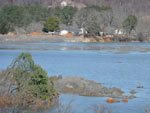The governor said his state will have to integrate current restoration plans into a specific set of priorities and actions for government and nongovernment organizations.
The National Wildlife Federation campaign week is the time to get those "inside kids" to take a walk on the wild side.
Scientists are just beginning to learn more about the influence of ocean currents on ice sheets.
By the end of this century, scientists project that much of the tropics and subtropics will exceed 86 degree Fahrenheit in the growing season and affect important food crops.
Earthjustice files lawsuit to protect salmon and close loopholes.
"No Discharge Area" designations will end boat sewage in Camden, Rockport, Rockland, and portions of Owls Head, Maine.
Bottled water company gives $30,000 gift to be used to enhance wetlands for waterfowl and wildlife.
Trash disposal isn't the answer to keeping drugs out of the water supply after all.

Model research says that the prairie pothole region of central North America is much more sensitive to climate warming and drying than previously thought.
Viral hemorrhagic septicemia virus poses threats to fisheries and aquaculture.
Jim McClintock says the increased acidity of the seawater itself can literally begin to eat away at the outer surfaces of shells of existing clams, snails, and other calcified organisms, which could cause species to die outright or become vulnerable to new predators."

EPA says many of the electric utilities the agency has assessed are already implementing recommended measures to make their impoundments safer.
Corps of Engineers seeks comments on its draft environmental impact statement on the Angelina & Neches River Authority project under Section 404 of the Clean Water Act and Section 10 of the Rivers and Harbors Act.
University of Maryland and Baylor University ecologists may have discovered a lower ecological "tipping point" at which species are threatened.
The U.S. Geological Survey says the increase is due to the agency's significant role in climate change monitoring and adaptation, energy, ecosystems, and other priorities.
The National Academy of Sciences should limit itself to the science of the conservation plan and the environmental needs of the Bay Delta, according to the Environmental Defense Fund.
Johns Hopkins University researchers suggest that lower nutrients and oysters could help keep algal blooms down in U.S. waterways.